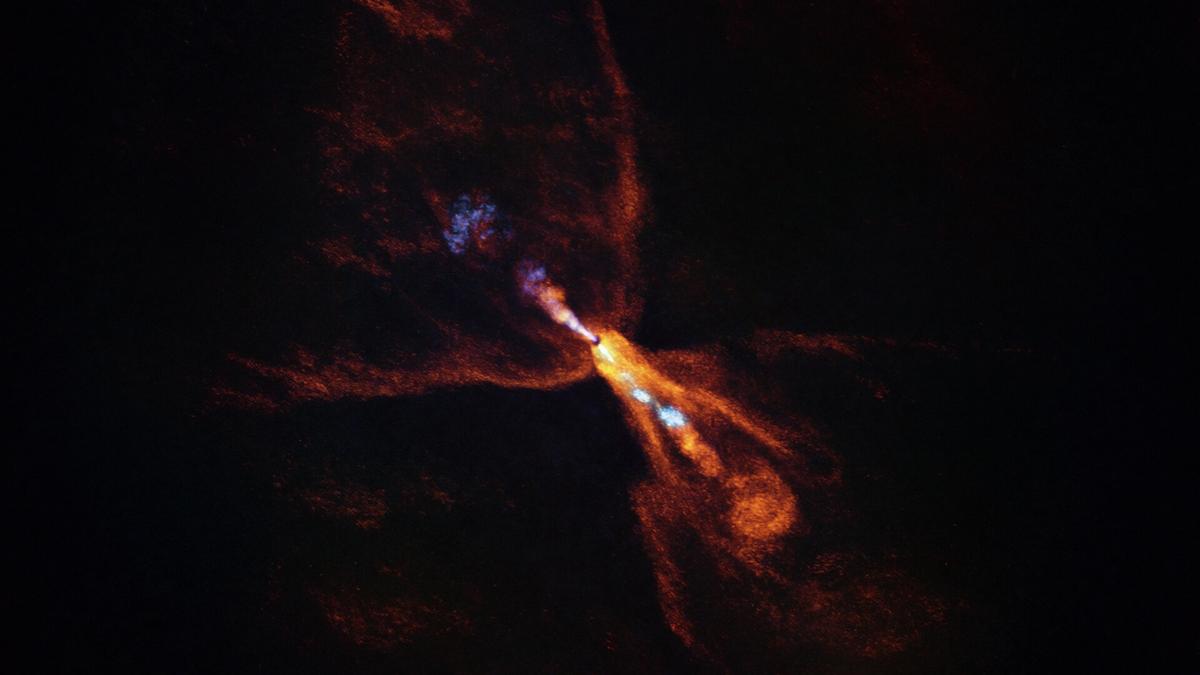HOPS-315, a baby star where astronomers have observed evidence for the earliest stages of planet formation, as imaged by ALMA.
| Photo Credit: ALMA(ESO/NAOJ/NRAO)/M. McClure et al.
When rocky worlds like the earth began to form, dust in the young Solar System was first heated until it vaporised and then cooled so that the very first, refractory (i.e. heat-loving) minerals could crystallise. Catching that moment in another star system would show astronomers exactly how planet formation begins — but no one had seen it before. A new study in Nature this month has reported just such an event.
By examining the star HOPS‑315 in Orion, whose protoplanetary disc is tilted just enough for someone on or near the earth to peer deeper within, researchers from France, the Netherlands, Sweden, Taiwan, and the US observed raw rock vapour cool and crystallise.
The protoplanetary disc is a flat, rotating pancake-shaped mass of gas and dust that surrounds a newborn star. Inside it, dust grains bump together, stick, and gradually grow into rocks, planets, moons, and other bodies while the gas creates atmospheres and influences the planets’ long-term orbits.
The observations themselves were conducted by the NASA James Webb Space Telescope and the Atacama Large Millimeter/sub‑millimeter Array (ALMA) observatory in Chile. In 2023, the team used the NIRSpec and MIRI integral‑field spectrographs onboard the telescope to collect sharp energy readings across a range of frequencies. Eight months later, ALMA observed the same system for signs of carbon monoxide, silicon monoxide and sulphur monoxide.
Together, the telescope traced warm gas and dust only a few stellar radii from the star while ALMA mapped cooler gas farther out.
The telescope’s data contained evidence of a strong band of silicon monoxide gas at around 470 K as well as crystalline silicates. Both lay within 2.2 AU of the star — well inside Mercury’s orbit if this were in the solar system. (1 AU equals the earth-sun distance.)
The team also ran computer simulations, which predicted that around 1 AU from the star, temperatures hovered around 1,300 K, which is the temperature at which dust just begins to evaporate. The study’s energy readings matched the prediction: that interstellar grains must have vaporised there, releasing silicon monoxide gas that then cooled and re-condensed into fresh shards of crystals.
According to the study, the relative quantities of crystals of forsterite, enstatite, and tentative silica were reminiscent of inclusions — i.e. minerals trapped inside minerals — that have been found in primitive meteorites on the earth, meaning that a similar condensation chemistry is under way around the star.
The ALMA data also revealed no slow silicon monoxide at the star’s position whereas the Webb telescope’s data was blueshifted by around 10 km/s. Together, they indicate that the minerals lay inside the rising disc atmosphere, the thin upper layer of gas and dust above the mid‑plane of the protoplanetary disc, rather than in the material pouring out of the star.
Thus the study has reported the first evidence of solid matter condensing out of rock vapour around a star, a.k.a. the first step of planet formation.
Published – July 23, 2025 02:47 pm IST
